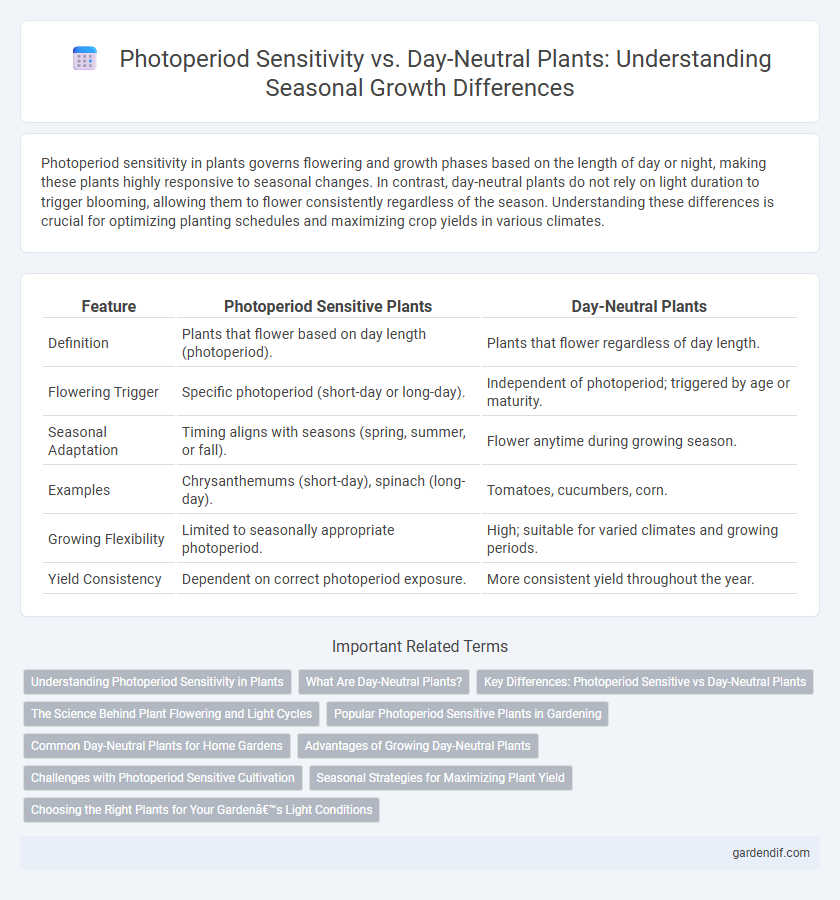
Photoperiod sensitivity vs Day-neutral plants Illustration
Photoperiod sensitivity in plants governs flowering and growth phases based on the length of day or night, making these plants highly responsive to seasonal changes. In contrast, day-neutral plants do not rely on light duration to trigger blooming, allowing them to flower consistently regardless of the season. Understanding these differences is crucial for optimizing planting schedules and maximizing crop yields in various climates.
Table of Comparison
| Feature | Photoperiod Sensitive Plants | Day-Neutral Plants |
|---|---|---|
| Definition | Plants that flower based on day length (photoperiod). | Plants that flower regardless of day length. |
| Flowering Trigger | Specific photoperiod (short-day or long-day). | Independent of photoperiod; triggered by age or maturity. |
| Seasonal Adaptation | Timing aligns with seasons (spring, summer, or fall). | Flower anytime during growing season. |
| Examples | Chrysanthemums (short-day), spinach (long-day). | Tomatoes, cucumbers, corn. |
| Growing Flexibility | Limited to seasonally appropriate photoperiod. | High; suitable for varied climates and growing periods. |
| Yield Consistency | Dependent on correct photoperiod exposure. | More consistent yield throughout the year. |
Understanding Photoperiod Sensitivity in Plants
Photoperiod sensitivity in plants determines flowering and growth based on the length of day and night, critical for optimizing crop yields and garden planning. Short-day plants require longer nights to flower, while long-day plants bloom when daylight exceeds a certain duration, contrasting with day-neutral plants that flower regardless of day length. Understanding these responses enables precise control over plant development cycles in agriculture and horticulture, enhancing productivity and adaptability to seasonal variations.
What Are Day-Neutral Plants?
Day-neutral plants exhibit growth and flowering independent of photoperiod, allowing them to thrive across varying seasonal lengths. Unlike photoperiod-sensitive species that rely on specific light durations to trigger flowering, day-neutral plants respond primarily to age or developmental stage. This trait makes them highly adaptable for continuous cultivation and extended harvest periods.
Key Differences: Photoperiod Sensitive vs Day-Neutral Plants
Photoperiod-sensitive plants rely on specific lengths of daylight and darkness to trigger flowering, making their growth cycles closely tied to seasonal changes. In contrast, day-neutral plants flower regardless of day length, allowing for continuous or repeat blooming throughout various seasons. Understanding these key differences is crucial for optimizing planting schedules and maximizing crop yield based on regional daylength variations.
The Science Behind Plant Flowering and Light Cycles
Photoperiod sensitivity in plants is regulated by phytochrome proteins that detect changes in light duration, triggering flowering pathways when specific day lengths are met. Day-neutral plants bypass this mechanism, flowering regardless of photoperiod due to genetic traits that make their flowering response independent of light cycles. Understanding these molecular processes aids in optimizing crop yields by manipulating light exposure and selecting appropriate plant varieties for different growing seasons.
Popular Photoperiod Sensitive Plants in Gardening
Photoperiod sensitive plants respond to the length of daylight, making them essential for seasonal gardening, with popular examples including chrysanthemums, poinsettias, and soybeans. These plants require specific day lengths to flower, enabling gardeners to manipulate light exposure for optimal growth and bloom. Understanding photoperiod sensitivity aids in selecting and scheduling crops to match seasonal changes and improve yield efficiency.
Common Day-Neutral Plants for Home Gardens
Day-neutral plants such as tomatoes, peppers, and cucumbers thrive regardless of photoperiod changes, making them ideal for home gardens seeking consistent yields throughout varying seasons. Unlike photoperiod-sensitive plants that rely on specific daylight lengths to trigger flowering, day-neutral varieties flower based on age or maturity, simplifying cultivation. Their adaptability ensures extended harvest periods and less dependency on seasonal light variations, crucial for gardeners in regions with unpredictable sunlight patterns.
Advantages of Growing Day-Neutral Plants
Day-neutral plants offer consistent flowering regardless of day length, enabling multiple harvests throughout a growing season and maximizing yield potential. These plants adapt well to diverse climates and varying photoperiods, reducing management complexity and extending cultivation windows. Their flexibility supports continuous production cycles, which is essential for commercial growers seeking stable output and efficient resource use.
Challenges with Photoperiod Sensitive Cultivation
Photoperiod sensitive plants require specific light durations to trigger flowering, posing challenges in regions with fluctuating day lengths or unpredictable weather patterns. These plants often demand precise control of light exposure to ensure optimal growth and yield, complicating scheduling in commercial agriculture. In contrast, day-neutral plants flower regardless of day length, offering greater flexibility but potentially limiting the ability to time harvests for peak market demand.
Seasonal Strategies for Maximizing Plant Yield
Photoperiod-sensitive plants rely on specific day lengths to trigger flowering, optimizing seasonal growth by aligning their reproductive phase with favorable environmental conditions. Day-neutral plants, unaffected by day length, maintain continuous flowering and fruiting cycles, enabling consistent yield throughout various seasons. Combining these strategies allows growers to select crops based on regional photoperiod patterns, maximizing overall plant productivity and seasonal yield efficiency.
Choosing the Right Plants for Your Garden’s Light Conditions
Photoperiod sensitivity in plants determines their flowering response based on day length, with short-day, long-day, and day-neutral categories affecting growth cycles. Selecting plants matched to your garden's natural light periods ensures optimal blooming and productivity, as photoperiod-sensitive species require specific daylight durations to trigger flowering. Day-neutral plants offer flexibility, blooming regardless of day length, making them ideal for variable or unpredictable light environments.
Photoperiod sensitivity vs Day-neutral plants Infographic

 gardendif.com
gardendif.com